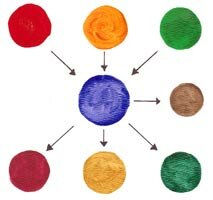Rectangular Tetrad Color Scheme

Working with a Rectangular Tetrad means juggling four colors. Simply put, you’re choosing a rectangle of four colorson the basic color wheel.
That means you are always working with two pairs ofComplementary Colors. It makes things a bit tricky. Your mixtures can quickly become dark and dreary unless you blend in colors with a very light touch.
In any Rectangular Tetrad color palette, you have:
- Three sets of Two Primary Colors combined with Two Secondary Colors
- Three sets of Four Tertiary Colors
The first thing you need to do after deciding to use a Rectangular Tetrad color scheme, is select your dominant Hue or Mother Color, which is Blue in our example.
Next select the color two spots over. You could go either clockwise or counterclockwise. In our example we go clockwise which gives us Green. Now just go straight across the Color Wheel and form a rectangle by choosing the opposite two colors.
In this example our color scheme is Blue + Green + Orange + Red. There are two Primary Colors and two Secondary Colors.
Six choices multiplied by four points of view equals twenty-four palettes.
Choosing one of your four rectangular tetrad colors to be the dominant, ‘Mother Color’completely changes the overall effect. For example, an Orange + Red + Green + Blue color plan will be much different than a Blue + Red + Orange + Green color plan. Even though the same hues are being used, the look of your palette changes as the emphasis is placed on mixtures with an alternate Mother Color as its root.
The result will also vary in boldness and sophistication based on which pairs you choose. When you use pairs of Primary Colors and Secondary Colors as we have here, the resulting color scheme will be more vibrant and bold.
When your choice of pairs is the Tertiary Colors you’re working with color mixtures to begin with, so the results will be more complex.
Example of a Rectangular Tetrad

In this case, I’ve chosen Blue as my main color and placed it in the middle. Pure Red, Orange and Green are shown on the top row.
By adding a tiny bit of Blue to the three paint colors on the top row, you’ll get some interesting results which you can see on the bottom row. If you add more blue to each the colors will change even more. Remember that Orange is a Complementary Color of Blue, so your mixture canquickly become gray. That can be an advantage if you understand your pigments well.
Red + a little Blue = Burgundy
Orange + a little Blue = Gold or ++ Blue = Gray
Green + a little Blue = Forest Green
Red + Orange + Green + Blue = Neutral Brown or Gray
To get the Neutral Brown in the middle row on the right, all you need to do is mix all four colors together. Neutral gray can also be created depending on the balance of the mixture. Again there’s no guesswork as to which neutral to use, because all these colors are part of a blended family. Be sure to add paint mixtures in tiny increments for best results.
Notice how the paint mixtures on the bottom row also work well together. There’s never any clashing with this method.
Painting Tips for a Rectangular Tetrad Color Scheme
- Make one of your colors dominant in your palette. This is your Mother Color. To absolutely make sure your colors don’t clash, put a TINY smidgen of it in every mixture. Keep itsubtle for best results.
- Use various intensities of your chosen hues by mixing different proportions. Then adjust the values by creating tints, shades and tones.
- For contrasting accents, choose one of the non-dominant colors. Make sure it has a tiny bit of the dominant Mother Color mixed in to soften it a touch.
- Before you start a project, experiment with various balance of mixtures on a piece of paper or in your sketchbook as reference. It will give you a better feel of the full range of colors you can achieve.
- Some pigments mixed in will be strong and overpower your starting color. Only mix a tiny bit at a time until you know your pigments well. Beware of the darkest colors Blue, Violet and Black.
Check out these Color Schemes
Complementary
Near Complementary
Triad
Complementary Triad
Modified Triad
Square Tetrad
Adjacent Tetrad
Analogous
Analogous Complementary
Multi-Color

